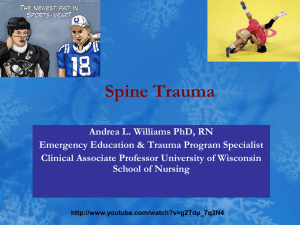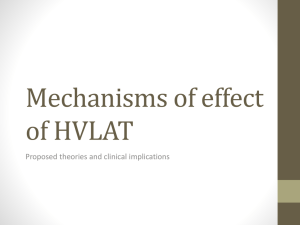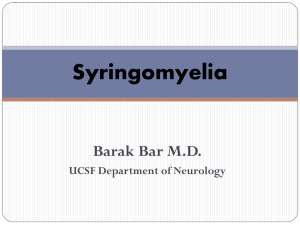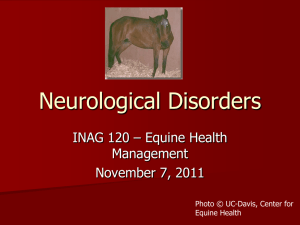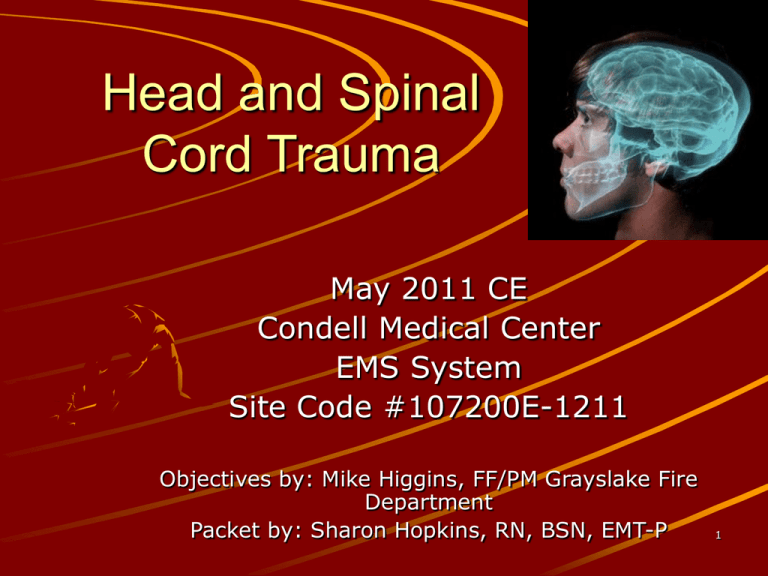
Head and Spinal
Cord Trauma
May 2011 CE
Condell Medical Center
EMS System
Site Code #107200E-1211
Objectives by: Mike Higgins, FF/PM Grayslake Fire
Department
Packet by: Sharon Hopkins, RN, BSN, EMT-P
1
Objectives
Upon successful completion of this module, the
EMS provider will be able to:
1. List risky behaviors contributing to brain and
spinal cord injuries.
2. Describe typical injury patterns related to
specific mechanisms of injury.
3. Describe the anatomy of the brain.
4. List contents of the skull.
5. Describe the mechanisms for the development
of secondary brain injury.
6. Describe the pathophysiology of traumatic brain
injuries including pressures related to brain
blood flow.
7. Explain the normal anatomy and physiology of 2
the spinal column and spinal cord.
Objectives cont’d
8. Describe the pathophysiology of traumatic
spinal cord injuries.
9. Describe components of a neurological
assessment in the field.
10. List signs and symptoms of spinal cord
injuries.
11. Describe the pathophysiology of neurogenic
shock.
12. Describe prehospital treatment based on
Region X SOP’s of the patient with a head or
spinal cord injury.
13. Review ventilation rates of the stable and
unstable patients with head and/or spinal cord
3
injuries.
Objectives cont’d
14. Review the Region X Infield Spinal Clearance
SOP.
15. Review measurement of fitting a cervical
collar.
16. Review the procedure for demonstrating the
standing backboard takedown procedure.
17. Demonstrate the proper measurement
and placement of a cervical collar.
18. Demonstrate the standing take down
with the back board.
19. Actively participate in case scenario
discussion.
20. Successfully complete the post quiz with a
score of 80% or better.
4
What’s The Big Deal?
Traumatic brain injury (TBI)
– Major cause of death and disability in
multiple trauma patients
– Severe injury indicated with GCS <9
5
TBI Statistics
Many
patients will
be minors,
therefore,
you will also
be dealing
with
parents and
caregivers
6
Traumatic Brain Injury (TBI)
40% of trauma patients have CNS injury
Death rate twice as high (35%) as patient
without CNS injury
Account for 25% of all trauma deaths
Account for up to 50% of all MVC deaths
Cost worldwide is huge
– Lives lost
– Families destroyed
– Money spent for care
CNS – central nervous system
7
Risky Activities Resulting in Spinal
Cord Injuries
MVC – 44.5% - major cause
– SUV’s & jeeps prone to flipping
Falls 18.1%
– Most common in persons >45 years of age
Violence 16.6%
– More common in urban settings
Sports 12.7%
– Diving most common contributing sport
Other medical causes make up <10%
8
Typical Head/Neck Injury Patterns
T-bone – lateral impact
– Coup/contrecoup head injuries
– Neck strain up to fractures
– Most injuries from collision with inside of vehicle
Rear impact
– Hyperextension of neck esp if head rest not fitted
– Lumbar spine injury if seat breaks
Rollover
– Body impacted in all directions so injury potential
high
– Increased chance for axial loading on spine
– Often lethal injuries when ejected
9
Typical Head/Neck Injury Patterns
ATV
– Injuries depend on MOI and part of
body impacted
– High index of suspicions for head and
spinal injuries
Falls from height
– Evaluate distance, body area impacted,
type of surface struck
– Landing on feet, check for axial loading
to lumbar and cervical spine areas
10
Anatomy of
the Skull
Scalp highly vascular
Skull is rigid bone
– Serves as protection
Dura mater
– Tough fibrous
covering of brain
Arachnoid mater
– Lies under dura
– Arteries & veins
suspended from this
Pia mater
– On surface of brain
11
Anatomy of the Brain
Each lobe has a unique function
Identified disabilities can help
pinpoint area of insult or injury
– Proper assessment can point to area of
injury
– Always reassess watching for trends
12
Anatomy of the Brain
Cerebrum
– Frontal lobe
Personality
Judgment
– Temporal lobe
Hearing
Memory
– Parietal lobe
Language
formation;
processing
senses
– Occipital lobe
Vision
13
Anatomy cont’d
Cerebellum
– Control of movement,
balance, coordination
Brainstem
– arousal & consciousness center;
involved in basic life functions
breathing, reflexes
– Pons – motor & sensory relay
center
– Medulla- controls autonomic
functions (breathing,
digestion, heart & blood
vessel function
14
Contents of the Skull
There is no extra space
If one component increases, usually
brain tissue swelling, it is usually at
sacrifice of one of the other components
–Brain – 80%
–Blood volume – 10% (150 ml)
–CSF – 10% (150 ml )
15
CSF – cerebral spinal fluid
Brain Function
Brain VERY sensitive to levels of
oxygen and glucose
– Brain has a high metabolic rate both at
rest or engaged in activity
– Brain is 2% of total body weight
– Receives 15% of cardiac output
– Consumes 20% of body’s oxygen
– Relies on aerobic metabolism
– Needs constant availability of glucose,
thiamine (to metabolize glucose), and
oxygen
16
Comparative Blood Flow in ml/minute
Organ
At rest
During strenuous
activity
Heart
250
750
Skin
400
1900
Other
600
400
Brain
750
Steady at 750
Skeletal muscle
1000
12,500
Kidneys
1200
600
Viscera
1400
600
Total
5600
17,500
17
Adding Insult to Injury
Coup-contrecoup injuries
– Brain shifts/floats inside skull
Base of skull rough – causes more injury
– Injuries at point of impact and away
from point of impact
Ex: forehead
injury can result
in additional
injury to
occipital area
18
Secondary Injury
Primary injury occurs at time of
insult
Secondary injury occurs later as a
result of what happens initially
Initial swelling causes decreased
perfusion
Secondary complications stem from
hypoxia and decreased perfusion
19
What is your major focus?
Management of injury focused on
– Proper care
Identification of injuries
–An accurate general impression
leads to appropriate care
Appropriate interventions initiated
– Rapid transport to secondary care
Do things right to prevent
contributing to secondary injuries
20
Common Problems Related To TBI
Airway compromise
Inadequate ventilation
Hypotension
– An independent risk factor contributing
to mortality
Focus on these critical aspects and
perform appropriate interventions as
needed
21
Pressures Related to Blood flow
ICP is pressure of brain and contents
within skull
CPP - cerebral perfusion pressure
–Pressure of blood flowing thru
brain; pressure necessary to
perfuse brain (CPP=MAP-ICP)
MAP - mean arterial pressure
–Average pressure within an artery;
pressure maintained in vascular
system
22
Reflexive Response to ICP
Cushing’s reflex
– Protective response to preserve blood flow to
the brain
B/P will increase
Systolic B/P increasing as diastolic
B/P stays same or increases
Widening pulse pressure
Heart rate will decrease
Effort to lower elevating blood pressure
Respirations may be irregular
Note vital signs move opposite to
shock
23
Cerebral Perfusion
Brain requires unique range to function
Increased ICP causes brain herniation
Hypotension not tolerated with ICP
Examples of problems*:
– MAP constant + ICP = CPP
– MAP decreases + ICP steady = CPP
– MAP decreases + ICP = CPP critical
Any negative change in B/P or ICP affects
blood flow in brain
*Normal values of MAP, ICP, and CPP listed in Notes section
24
Signs and Symptoms Head Injury
Use inspection/observational skills
with mechanism of injury to increase
suspicion of head and neck injuries
25
Brain Injuries - Concussion
Prevalent in athletic activities
No structural injury to brain
Often brief loss of consciousness or, at
minimum, confusion, then return to
normal
Possible amnesia (short-term retrograde)
Short term memory loss – will ask
repetitive questions
Dizziness, headache, ringing in ears,
nausea
26
Brain Injuries – Cerebral Contusion
Bruised brain tissue
History prolonged unconsciousness
or serious altered level of
consciousness (confusion, amnesia,
abnormal behavior)
Focal neurological signs
– Related to a specific area of the brain
– Weakness, speech problems, personality
or behavioral changes
27
Brain Injuries – Subarachnoid
Hemorrhage
Blood in subarachnoid space
– Traumatic injury or spontaneous
Blood causes irritation
Severe headache
– “Worst headache of my life”
Coma
Vomiting
28
Brain Injuries – Diffuse Axonal
Injury
Most common type of injury from
blunt head trauma
Generalized, diffuse edema
Unconscious
No focal deficits
– Swelling, edema, injury too widespread
so no specific isolated sign/symptom
pointing to 1 area of the brain
29
Brain Injuries – Acute Epidural
Hematoma
Bleeding between dura and skull
Often from tear in middle meningeal artery
from skull fracture in temporal area
– Runs along inside of skull in temporal area
– Arterial bleed so onset usually rapid for
signs/symptoms
Initial loss of consciousness and now lucid
Signs ICP after few hours
– Vomiting, headache, altered mental status
– Motor deficit opposite side to injury
(contralateral)
30
– Dilated, fixed pupil on side of injury (ipsilateral)
Brain Injuries – Acute Subdural
Hematoma
Bleeding between dura and arachnoid
Bleeding is venous
Slow onset to ICP (hours, days)
Headache, changing level of consciousness,
focal neurological signs
– Weakness one sided, slurred speech
Poor prognosis due to associated brain tissue
injury
High risk: elderly, anticoagulant use, chronic
alcoholics
31
Brain Injuries – Intracerebral
Hemorrhage
Bleeding within brain tissue
Blunt or penetrating injuries
Surgery not often helpful
Signs and symptoms depend on region of
brain injured
Patterns similar to a patient with a stroke
Altered level of consciousness common
If awake, complain of headache &
vomiting
32
Spinal Column
Spinal column is the bony tube
of 33 vertebrae separated by
discs that act as shock
absorbers
Alignment maintained by
strong ligaments and muscles
Supports body in upright
position
Allows use of extremities
Protects delicate spinal cord
33
Spinal Cord
Electrical conduit
Extension of brain stem
Continues down to first lumbar
vertebrae then separates into nerves
Surrounded and bathed by
cerebrospinal fluid
Cerebrospinal fluid and flexibility
provide some protection
34
Spinal Column/Cord
35
Spinal Cord cont’d
Nerve roots exit at each vertebral level
– Nerve roots carry signals from brain to
specific sites
– Nerve roots carry sensory signals from
body to spinal cord to brain
– Susceptible to
traumatic injury
36
Spinal Cord cont’d
Integrates/brings together the
autonomic nervous system
–2 components: parasympathetic
and sympathetic nervous system
–Assists in controlling
Heart rate
Blood vessel tone
Blood flow to skin
37
Mechanisms of Injury
Penetrating
injuries
– Secure the
object in
position
found
– Do no
further
harm!
38
Mechanisms of Blunt Spinal Injury
Hyperextension
– Excessive posterior movement of head
or neck
Face into windshield
Elderly person falling to floor, striking chin
Football tackler
Dive into shallow water
Hyperflexion
– Excessive anterior movement of head
onto chest
Rider thrown from horse or motorcycle
Dive into shallow water
39
Mechanisms cont’d
Compression
– Weight of head or pelvis driven into
stationary neck or torso
Dive into shallow water
Fall onto head or legs >10-20 feet
Rotation
– Excessive rotation of torso or head &
neck; moves one side of spinal column
against other side
Rollover MVC
Motorcycle crash
40
Mechanism cont’d
Lateral stress
– Direct lateral force on spinal column;
typical shearing one level of cord from
another
T-bone MVC
Distraction
– Excessive stretching of column and cord
Hanging
Child inappropriately wearing shoulder belt
around neck
“Clothes lining” with snowmobile or
motorcycle riders and passengers
41
Disk Problems
A preexisting
problem can
be aggravated
at time of
injury
42
Spinal Cord Injuries
Complete injury
– No function, sensation, voluntary
movement below level of injury
– Both sides affected equally
Incomplete injury
– Some function preserved below level of
injury
– May move 1 limb more than other
– May have more function on 1 side of
body than other
– May have sensation but no movement
43
Spinal Cord Injuries
Tetraplegia (also referred to as
quadriplegia)
– Injury in cervical area
– Loss of muscle strength in all 4 extremities
Paraplegia
– Injury in spinal cord in thoracic, lumbar or
sacral segments
– Level of impairment dependent on level of
injury
44
Spinal Cord Injury Patterns
Cervical area injury = quadriplegic
C1-C2 – may lose involuntary function of
breathing
– Watch for excessive use of abdominal muscles
to breath
C4 and above – often require use of
ventilator for breathing
C5 – shoulder/bicep control but no control
of hand or wrist
C6 – wrist control but no hand function
45
Spinal Cord Injury Patterns
C7-T1 – can straighten arms,
dexterity problem with fingers and
hands
Thoracic level and below = paraplegic
T1-T8 – has control of hands, poor
trunk control due to lack of abdominal
muscle control
T9-T12 – good trunk & abdominal
muscle control; sitting balance good.
Decreased control hip flexor and legs
46
Spinal Cord Injury Consequences
Often experience:
– Bowel and bladder dysfunction
– Male fertility often affected
– Inability to regulate B/P; hypotension
usual
– Inability to sweat below level of injury
– Decrease control to regulate body
temperature
– Chronic pain
47
Dermatomes
Mapping of
body
Easier to
identify
injured areas
by isolating
location of
complaints as
related to
zones of
altered
sensation
48
Neurogenic Shock
Occurs when brain signals
interrupted for autonomic functions
Ability to vasoconstrict limited
– No sympathetic tone, vessels dilate
Relative hypovolemia
– preload ventricular filling Frank
Starling reflex contraction strength
cardiac output
– No hormone release to heart rate
49
Neurogenic Shock
Signs and symptoms
–Bradycardia
–Hypotension
–Cool, moist, pale skin above cord
injury
–Warm, dry, flushed skin below cord
injury
50
Neurological Assessment
Serial vital signs – watch for:
– ICP: B/P; pulse rate
– Neurogenic shock B/P; pulse; skin warm
and dry below level of injury
Serial AVPU
Serial GCS
Pupillary response
Response to motor and sensory
– Included in CMS, SMV, PMS assessment
Babinski reflex present – big toe extends
up when sole stroked from heel to toe
51
Signs and Symptoms Spinal Cord
Injury (ie: “Clues”)
Pain on movement of back or spinal cord
Deformity
Guarding against movement
Loss of sensation
Inability to move
Weak or flaccid muscles
Abnormal positioning
Loss of control of bladder or bowels
Priapism – erection of penis
Neurogenic shock
52
Focus of Field Treatment
Provide adequate airway
Monitor for effective oxygenation and
ventilation
Maintain CPP (cerebral perfusion pressure)
– Can’t measure easily in field
– So watch systolic blood pressure
Something EMS can monitor in the
field
Assume low B/P due to hypovolemia until
proven otherwise
53
Region X SOP
Routine trauma care
– Scene size-up
Determining mechanism of injury could be
good tip-off to suspected injuries
– Initial/primary survey
Identify and treat life threats
– Identify transport priority
– Perform rapid trauma survey if critical or
life threats found
– Focused exam on minor injuries
54
Region X SOP Head/Spinal Injuries
Routine trauma care
Obtain GCS
– GCS<9 indicates severe brain injury
IV fluid challenge (200 ml
increments) if B/P <90mmHg
If altered LOC obtain blood glucose
– If <60 treat with Dextrose
Assess oxygenation
– Maintain SpO2 >94%
55
Ventilation Rates
Stable Head/Spinal Injuries
Relatively stable patient needing BVM
assistance with 100% O2
Adult 10 breaths/min
1 breath every 6 seconds
Child 20 breaths/min
1 breath every 3 seconds
Infant 25 breaths/min
1 breath every 2.5 seconds
56
Ventilation Rates
Unstable Head/Spinal Injuries
Rapid neurological deterioration
– Unequal pupils, posturing, lateralizing
signs
Signs indicating a deficit related to one of the
hemispheres
– Example: speech problem, hemiparesis, abnormal
reflexes, facial asymmetry, abnormal eye movement
– Ventilate with BVM and 100% O2
Adult 20 breaths/minute (1 every 3 seconds)
Child 30 breaths/minute (1 every 2 seconds)
57
Infant 35 breaths/min (1 every 1.7 seconds)
Hazards of Hyperventilation
Hyper/hypoventilation refers to level of
CO2 maintained in body
Capnography is the ideal measurement
tool for exhaled CO2 levels
Levels of CO2 influence vessel size
– RR CO2 retained vasodilation
– RR CO2 retained vasoconstriction
– Either way, the brain does not get perfused
Hypoxia develops
– Hypoxia anaerobic metabolism acidosis
58
Unhealthy Environment
Hypo and hyperventilation both with
adverse consequences for the patient
Development of hypoxia and acidosis
– Hypoxia is NOT tolerated in the brain
Cells do not function well in this
environment
Interventions not effective in this
environment
59
Trauma Patient
Assume any injury from the clavicles
on up includes a head and/or spinal
cord injury
– Cannot clear the c-spine
– Perform spinal motion restriction
Also referred to as c-spine control
Avoid use of word “traction” as you are not
pulling on the head and neck
60
In-field Spinal Clearance
Evaluate
– Mechanism of injury
– Signs and symptoms
– Patient reliability
When in doubt, fully immobilize
Document assessment and findings
to support application of motion
restriction/immobilization devices or
when not using equipment
61
Cervical Collar Measurement
Why do we keep talking about how
to measure for placing a cervical
collar?
– We still see a high number of patients
transported to the ED with cervical
collars in the no-neck position
62
IF THE MAJORITY OF
YOUR PATIENTS ARE
WEARING A NONECK SIZED
COLLAR, THEN YOU
ARE NOT PROPERLY
MEASURING THEM!
63
Measuring for Cervical Collar
Measure eyeing horizontal line from
bottom of chin to top of shoulder
Measure on collar plastic from
bottom up to closest hole opening
Collar should rest
on clavicles &
support the jaw
64
Standing Backboard
A Team Effort Approach
65
Standing Backboard
Purpose
–To place the ambulatory patient into
a supine position without
compromising the spine
To rapidly move the patient into the
supine position will need 3 persons, a
cervical collar, and a long backboard
–Strapping can be (and most often is
best) applied once the patient is
supine
66
Standing Backboard
Position tallest crew member behind
patient
–Manual stabilization/motion restriction
of c-spine taken
2nd EMT measures and applies cervical
collar while manual control maintained
2 EMT’s position backboard between
patient and person maintaining manual
stabilization/motion restriction of head
and neck
67
Standing Backboard
2nd and 3rd EMT’s reach hand nearest
to patient under the patient’s armpit
and grasps the backboard
Patient will be temporarily suspended
by the armpits as the backboard is
lowered
As the signal is given, the backboard
is slowly lowered
68
Standing Backboard
Person with manual stabilization
walks backward to keep up with the
lowering pitch of the backboard
Remember
– Heaviest weight of head is in occipital
area
Have fingers/hands spread in good
position to support the head before
changing the patient’s positioning
69
Backboard
slowly
lowered
using multiple
personnel and
keeping head
and neck
immobilized
70
Standing Backboard
As the board is lowered, all 3
persons work very closely together
Once the backboard is lowered, the
patient may need to be adjusted
onto the backboard
Complete spinal
immobilization/motion restriction
process by securing the patient to
the backboard
Rescuers need to watch their own
body mechanics to prevent injury
71
Case Scenarios
Divide into smaller groups
Read the presentation
Form a general impression
Discuss treatment options
Discuss what/how/when to reassess the
patient
Decide what treatment to continue or
what adjustments need to be made
Present to the group and give explanation
to defend your decisions
72
Case Scenario # 1
17 y/o patient injured at bike track
– Fell head first off bike
Conscious, confused
VS: 92/50; 60; 14
Repeat: 84/46; 54; 14
Arms not moving
Legs move
c/o pain to neck
Warm & dry
73
Case Scenario # 1
No allergies; no medications
No medical history
Last ate 2 hours ago
Doesn’t remember how he wiped out
Reported to lose control speeding around
track
Upon arrival, bystanders holding c-spine
No movement detected in upper
extremities; lower ext move spontaneously
If “belly” breathing noted, what does it
mean?
– Excessive use of abdominal muscles
– Watch for respiratory arrest
74
Case Scenario #1
Treatment/interventions
– C-spine control - Spinal motion
restriction
– IV – O2 – monitor (what should be
enroute?)
– Fluids
– Prepare to support ventilations
– Obtain blood glucose level
75
Case Scenario #1
Patient had spinal cord injury
– Central cord syndrome most common
with hyperextension
– Weakness/impairment in arms & hands
– Legs are spared
– Variable loss of sensation
Exhibiting neurogenic shock
– B/P; bradycardia
– Tank expanded with vasodilation –
needs IV fluids
76
Case Scenario #1
Belly breathing indicates cervical
injury until proven otherwise
Chest muscles and diaphragm not
being used for ventilation
Abdominal muscles back up to
ventilate
– Not use to this function
– Will tire/fatigue
– Patient may respiratory arrest
77
Case Scenario # 2
41 y/o male restrained driver T-boned
by SUV
Unconscious, shallow respirations
Vital signs: 146/82, 94, 32, SpO2 94%
Blood draining from left ear and left
nares
Diminished breath sounds on left
Deformed left arm, left femur
78
Case Scenario # 2
GCS:
– Eye opening – none
– Verbal response – moans
– Motor – Withdrawing on left, no movement on
right
Repeat VS: 168/72, 44, 16
Pupils: fixed/dilated left, right minimally
reactive
What would raccoon eyes or Battle’s signs
indicate?
79
Case Scenario #2
Treatment/interventions
– C-spine control - Spinal motion restriction
– IV – O2 – monitor (what should be
enroute?)
– BVM support at 20/minute (1 every 3
seconds) (patient unstable)
– Rapid transport to highest trauma level
within 25 minutes
– Obtain blood glucose level
80
Case Scenario #2
Patient injuries
– Fractured skull
Raccoon eyes indicate anterior basilar skull fx
– Epidural bleed
– Fractured left clavicle
– Fractured ribs with hemothorax
– Fractured left humerous
– Fractured pelvis
– Fractured left femur
81
Case Scenario # 3
60 y/o female riding her bike
Hit pothole and fell off bike
Helmet damaged
Short loss of consciousness; asking
repetitive questions; nauseated;
complains of headache and blurred
vision
Vital signs: 132/78, P-98, R-20,
SpO2 99%
82
Case Scenario # 3
GCS: eye opening spontaneous
– Verbal – slightly confused
– Motor – obeys commands
Pupils: PERL
83
Case Scenario #3
Treatment/interventions
– C-spine control – spinal motion restriction
Patient not reliable
– IV–O2–monitor (what should be enroute?)
– Watch for nausea and vomiting to protect
airway
– Trend vital signs and level of
consciousness
– Check blood sugar level
Patient has altered level of
consciousness
84
Case Scenario # 3
GCS – 4-4-6; Total 14
Patient had a concussion
Admitted overnight for observation
Continued to have a mild headache
Other complaints resolved
Discharged home next day
85
Case Scenario # 4
5 y/o is vomiting, has headache, was
acting “bizarre”
Now has an altered level of consciousness
Hx of falling off jungle gym earlier today
Initial loss of consciousness for few
minutes then lucid; alert & oriented
B/P 90/46, 104, 24
Nauseated
86
Case Scenario # 4
GCS:
– Eye opening – after calling their name
– Verbal response – talking nonsense
– Motor response – pulling at equipment with
right hand, trying to get your hands off him
Pupils - right slower to react, midsize
Left extremities flaccid
Bruise and swelling noted over right
forehead above ear
Minor scratches to bilateral arms
87
Case Scenario #4
Treatment/interventions
–C-spine control – spinal motion
restriction
–IV – O2 – monitor (what should be
enroute?)
–Anticipate rapid deterioration and
prepare to secure airway
88
Case Scenario # 4
GCS – 3-3-5; Total 11
Patient had right epidural hematoma
Confirmed on CT
Emergently taken to OR
Hematoma evacuated
Signs and symptoms slowly resolving
Patient discharged home with outpatient
physical and occupational therapy
89
Case Scenario # 5
Patient presents to ED with FB stuck
in head
Awake, talking,
following
commands
How do you
immobilize this
object?
90
Case Scenario #5
Immobilize in position found
Constantly monitor level of
consciousness
Possibly need to shorten a FB to
facilitate transfer in the ambulance
Not knowing where tip of FB is,
assume head and neck injuries and
treat for both
91
Case Scenario #5
Patient taken to OR
Arrow successfully removed with part
of skull
Plate placed in OR
Post-op patient had
altered sense of taste
and had difficulty
perceiving tactile
sensations
92
Case Scenario # 6
45 y/o male passenger
MVC involving a deer
Patient unconscious
Facial trauma evident
Gurgling respirations
Radial and carotid
pulses noted regular
and normal
93
Case Scenario # 6
Vital signs: 92/62, P-74, R-18
Pupils: right reactive, left non-reactive
GCS:
– Eyes – eyelids move when body touched
– Verbal – silent
– Motor – flexes right arm to pain, left arm
straightens to pain
Repeat VS: 88/50, P-62, R-28 irregular
94
Case Scenario #6
Treatment/interventions
– C-spine control – spinal motion restriction
– Open and secure airway
Modified jaw thrust
– Support ventilations 20 breaths per minute
– IV-O2-monitor (what should be enroute?)
– Rapid transport once extricated
– Is there a need for helicopter service in
your town/your location?
95
Case Scenario # 6
GCS – 2-1-3; Total 6
Pt had intracerebral hematoma and
bilateral pneumo/hemothorax
Chest tube placed in ED for chest
injuries
Remains on ventilator in ICCU
Unable to do brain surgery due to
location of bleed
96
New Recommendations of the AAN
American Academy of Neurology states
1. Any athlete who is suspected to have
suffered a concussion
• Remove from participation until
evaluated by a physician with training
in the evaluation and management of
sports concussions
2. No athlete should be allowed to
participate in sports if he or she is still
experiencing symptoms from a
concussion
97
AAN Recommendations cont’d
3. Following a concussion, a neurologist or
physician with proper training should be
consulted prior to clearing the athlete for
return to participation
4. A certified athletic trainer should be
present at all sporting events, including
practices, where athletes are at risk for
concussion
5. Education efforts should be maximized to
improve the understanding of concussion
by all athletes, parents, and coaches
98
TBI
Prevention is the most effective
treatment
–Use of restraints in vehicles
Shoulder/lap
Car seats
–Use of helmets
–Following guidelines when players
can return to play following
concussion
99
Hands-on Practice
All participants to measure a peer for
cervical collar placement
Practice in groups of 3 standing
backboard take-down
–Have 4th person role play a patient
100
Bibliography
Bledsoe, B., Porter, R., Cherry, R. Paramedic Care
Principles & Practices Third Edition. Brady. 2009.
Campbell, J.E. International Trauma Life Support
for Prehospital Care Providers, 6th Edition. Brady.
2008.
Region X SOP March 2007; amended January 1,
2008
101
Internet Reference Sites
http://www.answers.com/topic/intracranialpressure
http://www.bmj.com/content/338/bmj.b1683.full
http://faculty.washington.edu/chudler/facts.html
www.link-intl.com/gulfspine/Anatomy.html
http://neuropathology.neoucom.edu/chapter14/c
hapter14CSF.html
http://www.spinal-cord.org/at-risk-activities.htm
http://www.spinalinjury.net/html/_spinal_cord_1
01.html
102





